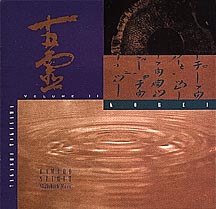

TAKASHITOKUYAMA
Volume II - KOREI
1. Kyorei (11'40")
2. Takiochi (11'32")
3.Murasakino-no-kyoku (4'20")
4. Sankara-sugagaki (4'05")
5. Shirabe-sagariha (6'31")
6. Tamuke (5'41")
7. Oshu-sashi (8'22")
8. Renbo-nagashi (10'48")
This piece is the oldest and closestin spirit to suizen (blowing Zen). Very straightforward in character,it is nevertheless a special piece and most respected of the honkyokurepertoire. The monk, Chohaku, had been fascinated by the soundof the wooden bell and sought to interpret that spirit of thebell to the shakuhachi. He subsequently taught this piece to Hotto,a fellow Zen monk, who founded Kokoku temple.
One is often overwhelmed by the presenceof water in Japan. The Izu Peninsula is renown for not only itsincomparable beauty, but also for its many onsen (hot springs)and waterfalls. One such waterfall, the Asahi falls located behindthe temple of Ryujenji, was the inspiration for Takiochi. Thestructure of the piece reflects the spirit of water as a smallquiet spring, a raging torrent, and finally the calm of a riveras it empties into an estuary. Since shakuhachi master KurosawaKinko studied this piece, its composition is dated from the Edoera in the seventeenth century.
This piece takes its name from a districtin northern Kyoto, in which the temple of Daitokuji is located.One of Japan's most celebrated Zen priests, Ikkyu, was sent toDaitokuji as a child for his education. Ikkyu was alleged to bethe illegitimate son of an emperor, and his mother is said tohave been of an anti-Imperial family. Ikkyu's heritage most certainlycontributed to his having a discreet upbringing. Nevertheless,we know from Ikkyu's writings that he played the shakuhachi, andindeed, nearly always carried one in his sash. Hence, the strongassociation of Ikkyu to Murasakino (which incidentally is alsothe birthplace of the Tozan school of shakuhachi), and this pieceis unmistakable in its attempt to convey Ikkyu's spirit of zen.Traditionally, the composition of Murasakino-no-kyoku is attributedit Ikkyu, but this has yet to be substantiated. Ikkyu is alsorenowned for his poetry and calligraphy; a sample of which illustratesthis cd cover.
Also known as Sankara-sugagaki, thispiece is thought to have originated from the older Meian Shinposchool of shakuhachi. However, to this day the history of thispiece remains a mystery. Because of the constant rhythm, somehave supposed that Sankara-sugagaki has been adapted from Kotomusic (This theory is reinforced by the fact that this piece isoften performed in ensemble). Therefore, the performance and informalornamentation of this piece is subject to strictly my own interpretation.
The Tsugaru Peninsula of northern Honshuisland is a unique cultural stronghold of Japan. Apart from adistinctive local dialect, the Tsugaru Peninsula has also producedunusual styles of shamisen and shakuhachi playing known as nezasahaKinpu-ryu. Two techniques used in Shirabe - sagariha include therhythmic blowing technique known as komibuki and a technique forusing the chin to produce a low tone known as chigiri. It is saidthat this Tsugaru style of musicianship was influenced by theseverity of the northern winters. Legend has it that when oneplayed the shakuhachi in the winter icicles would form at theend of the flute. Shirabe-sagariha is further distinguished inthe honkyoku repertoire in that it is associated with the Tsugarusamurai rather than Zen. The Tsugaru samurai were very independentand the Tsugaru daimyo even went so far as to proclaim the nezasahakinpu-ryu as a strictly local school. This piece is actually acombination of two short pieces, the first of which was composedby a man called Ban; otherwise, the exact origins of Shirabe-sagarihaare uncertain.
Although the composer is unknown, Tamukecomes from the city of Suzuka in Mie Prefecture. More specifically,we can say this piece originates from the temple of Fusaiji, whichhas preserved such honkyoku as Kakusuirei and Sakigake-no-kyoku.By using a melodic system of whole steps built around a minorscale, Tamuke creates a sublime and melancholic sentiment. Ithas a modern feeling and is ever reminiscent of Japanese Enkamusic.
Also known as Jimbo-sanya, this piecewas composed by Jimbo Masanosuke, the last monk of the templeof Echigomeianji, Hottajisen. Originally from Niigata Prefecture,Oshu-sashi is typical of the northern style of Koten honkyoku.It is at once loud and brash, but a moment later soft and subtle.The melody is similar to Futaiken, or the nezasaha school of shakuhachi.The uniqueness of this piece is characterized by the appearanceof new melodies throughout the composition, the juxtapositionof low and high notes, difficult fingering techniques, as wellas a sustained tension which is felt until the end of the piece.
The title of this piece has evolvedfrom the terms "reibo" or "reiho", all threeof which have essentially the same meaning, differing only innuance, and religious connotation. Three sections make up themusical structure of Renbo-nagashi. The first part establishesitself very quickly and melodically, and gradually becomes moresubdued as the first section ends. The second section uses lownotes in obtuse melodic patterns and rhythm which are unrelatedto part one. Finally, the piece concludes with a melodic themesimilar to that of the first section.
Afterword to Korei
This recording was made in November,1984 at a lodge in the Atami countryside. The recording sessiontook place late at night and all selections were recorded in singletakes; there is no editing or over-dubbing. During the five hoursof playing that went into the making of this record, I felt Ihad become one with the bamboo, and felt that this state of onenesswith the instrument is authentically reflected in this recording.My hope is to sincerely present the spirit of Koten honkyoku ineach volume of my shakuhachi recordings.
Priceof CDs / Priceof Sheet Music
![]() Volume I - Hi Kyoku
Volume I - Hi Kyoku
![]() Volume III - Shumi
Volume III - Shumi
![]() Volume IV - Michi
Volume IV - Michi
![]() Volume V - Kumoi
Volume V - Kumoi
![]() Tokuyama Honkyoku Sheet Music
Tokuyama Honkyoku Sheet Music
![]() Tokuyama Honkyoku Playing Guide
Tokuyama Honkyoku Playing Guide